We prepared for the worst and hoped for the best. Tropical Depression 9 dumped 20 inches of rain on Cuba as she made her way toward Forida. She picked up steam in the warm waters of the Gulf of Mexico and became Tropical Storm Hermine. Torrential, flooding rain preceded her arrive in our area, flooding streets in Bradenton with nearly 6 inches of rain in a few short hours. The Desoto Mall parking lot became a flood zone.

We watched, waited and watched some more, then packed our ditch bag in preparation for Tropical Storm Hermine. We watched as she turned from Depression 9 into Tropical Storm Hermine and we watched as she became a Hurricane. We had made plans, just in case. We had a safe refuge procured, a safe route to get there (rains had made some roads inpassable), and we had packed our few possessions we deemed irreplaceable in one of our “dry bags” and placed it in our backpack. We kept watching as she turned to the north and picked up speed. She passed to our north, wreaking havac in an area of Florida usually safe from storms.
We were spared the worst of the storm, but we were still visited by wind and more rain, but not as much. With storms predicted to miss our area, we set our emergency weather alerts and went to bed. Our astronimical high tides were exacerbated by storm surge, realeasing water in a dam upstream and more rain, but nothing like what the Governor’s speech made me invision. The worst thing that happened for us, was the damage to a neighbors sail on a roller furling. The sail sounded like a freight train in the wind, echoing in the water and vibrating our hull-for hours. We woke to gentle rains, cooler temperatures and gentle winds.
Life is good, but short, so in the words of William Perkey: “You’ve gotta dance like there’s nobody watching,love like you’ll never be hurt, sing like there’s nobody listening,and live like it’s heaven on earth.”
When you live aboard a boat and want to possibly move locally to another marina, it can be a complicated process. There are slip fees, taxes on the fees, electrical charges, pump out charges, live aboard fees, and sometimes other hidden fees. Slips are not all a uniform size either–you have to know how long your boat is (loa or length over all), how wide your boat is (beam) and the minimum depth you need (draft). Then you need to know if living on the premises is allowed, are your pets welcome, and what amenities you need or want. There are floating docks and stationary docks, tide tables, and rules. And if you are still somewhat land bound, you will find that most marinas do not provide adequate parking for your car or truck.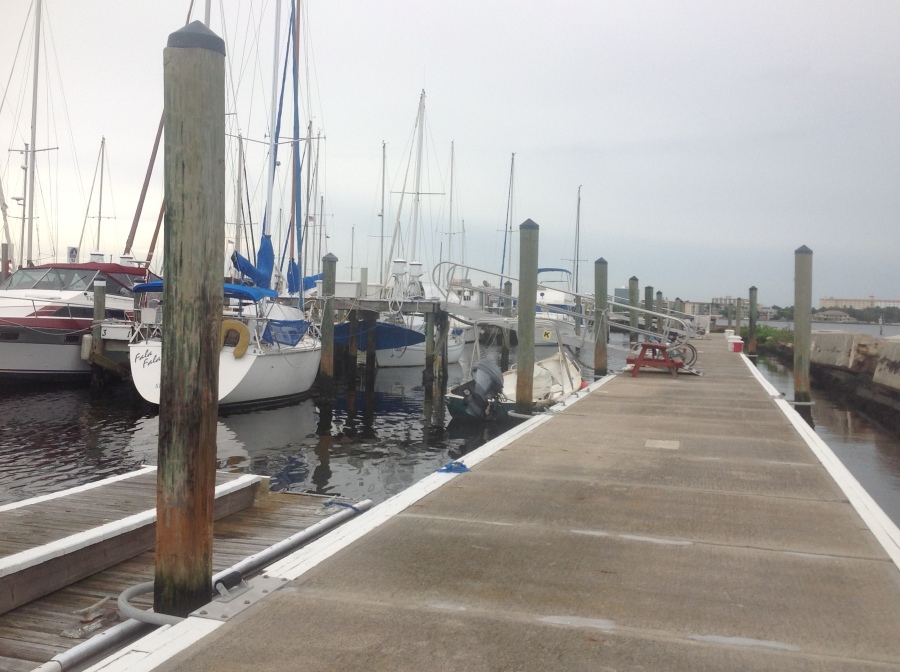
And you may need to know if your mast will fit under the bridge you will encounter on the way to the marina. Active Captain is a good place to start, but it’s not comprehensive, at least not yet. Today I have viewed several marinas in a 10 square mile area all claiming to be “the premiere” marina in the area, all with varying amenities and high price tags. Most do not allow liveaboards (people who live on their boats fulltime.) Marinas that do allow liveaboards often charge a monthly liveaboard fee that is supposed to cover ammenities, sometimes it is a per person charge. Electricity when plugged into a marina dock comes in at least three different configurations and you will need to know what your boat needs, because they are not interchangeable–the most common are: 30 amps and 50 amps.
Some marinas allow you to do work on your own boat, some do not–hoping you will hire them to do your repairs. Check for safety practices too–I’ve seen a lot of accidents waiting to happen at marinas. Some have a list of approved service providers, which often have to carry their own insurance. (One of my neighbors for example, cleans boat bottoms, but is not on the marina service provider list where he lives because the amount of insurance required to be on the list is prohibitive.) Safety applies to neighborhoods too.
There are also various discounts when shopping for marinas. Some give member discounts for membership in BoatU.S. , Sea Tow , or the America’s great Loop Cruiser’s Association . Yacht clubs also sometimes have a reciprocal agreement and seasonal rates often apply. Some require deposits, or first and last month’s slip fees for leases or damage deposits for transient slips. I have noticed prices increases compared to last year at this time too, and are not always reflected on a marina’s website. Email requests seem to get put aside at most marinas that I have dealt with so far, the best responses have been telephone calls during business hours–usually Monday-Friday in this part of Florida. So, if you need to find a wet slip (a slip in the water as opposed to one on land) at a marina make a list.
Know the make, model, year, hull type, LOA (length over all) of your boat, your beam width, your draft, and your mast height if applicable. Then keep a pen and paper along with a calculator handy. Ask about the slip fees, taxes, liveaboard fees, and pet restrictions. Ask about amenities and electrical outlets. Then, if you are planning to be at that marina for a while, visit the marina before signing on the dotted line so that you can check for safety issues. Wish me luck as I continue to look for that needle in a haystack–a perfect balance of price, amenities, safety and availability.
I finally decided how to start a thorough stern to bow inventory of our sailboat contents. Sounds simple enough, but if you are living aboard while trying to do the inventory, you have to find a place to put the stuff that is in the way of getting to the stuff you want to identify, count and maybe even photograph. I decided today was the day. I removed all of the bedding, including mattresses and memory foam pads on top of the mattresses. This is an opportunity to vacuum and clean the berth (bed) platform which houses storage lockers. There are three storage lockers under our bed in the aft cabin–starboard, center and port.
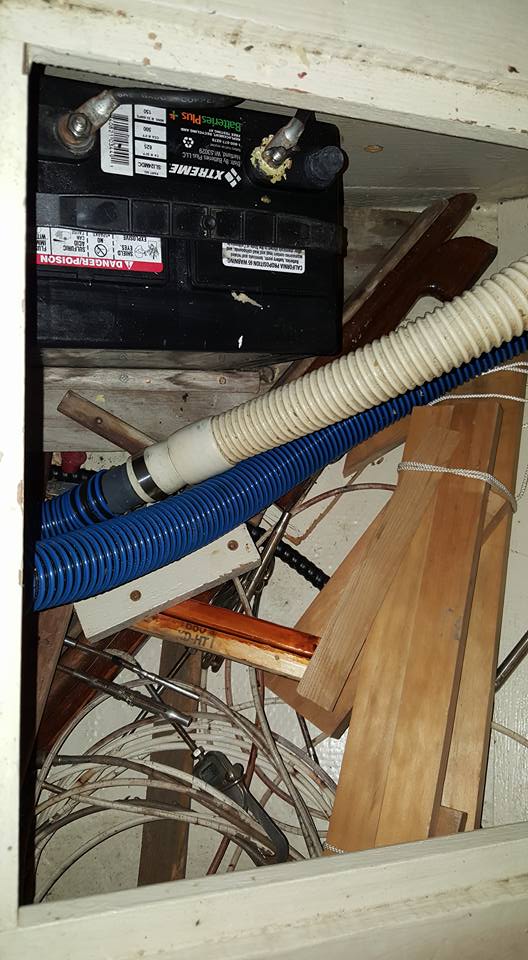
Our starboard locker houses one of our batteries, old life lines, and scraps of teak wood for repairs or leftovers from previous owner alterations.
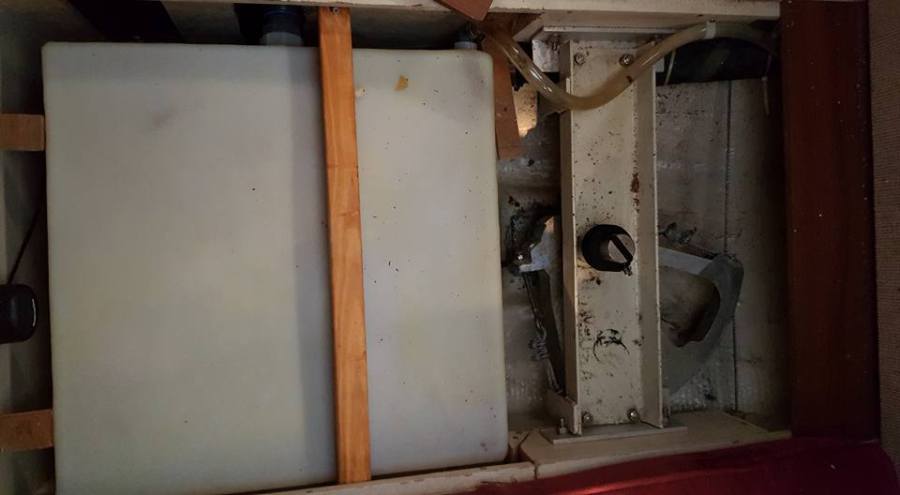
The center compartment holds a fairly new plastic black water holding tanks (yes a holding tank for poo), the depth sounder and steering mechanism for the rudder.)
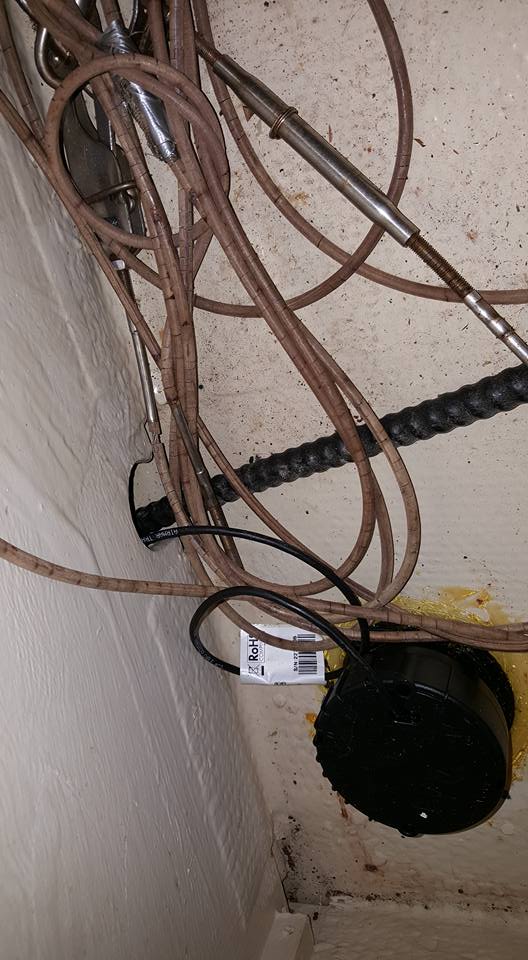
Port locker sans contents.
The starboard locker holds more old life lines, and something that appears to be our knotmeter (boat speedometer.)
I take photographs as well, because I may have misidentified an item that my husband is looking for and there are just too many mystery items on a boat to identify them as thingies. The port locker has items that may not respond well to shifting heavy objects, so I have opted to store our winter blankets there along with dry bags and duffles.
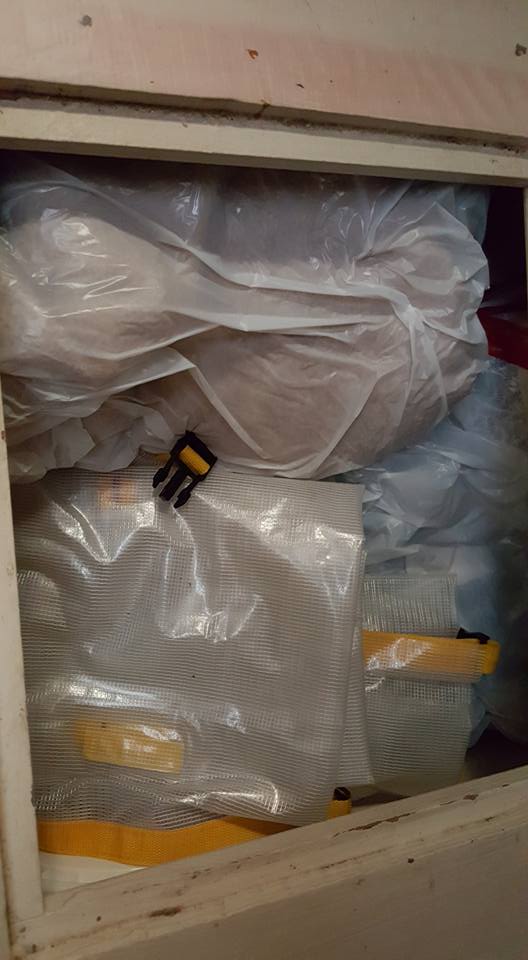
So, along with a list and a map of areas and the names I have given each locker, the inventory continues.
We love spicy food, but when storage space for spices in a tiny galley is a big issue, so how do you keep those spices on hand?
I scoured the internet. I questioned other boaters. And then I started experimenting. Maybe a small container with multiple spices would do. So when I saw this at one of my favorite stores and used it onboard. It is good for a short camping trip, but an unsatifactory solution, but it fits in a very small space. The wee multi-spice cabinet box–is cute, but just not enough for our purposes.



So, I began searching for anothe solution on the internet. My criteria: 1) easy access, 2) uses jars available anywhere, 3) room for lots of variey, 4) fits in my cabinet, and 5) doesn’t rust. 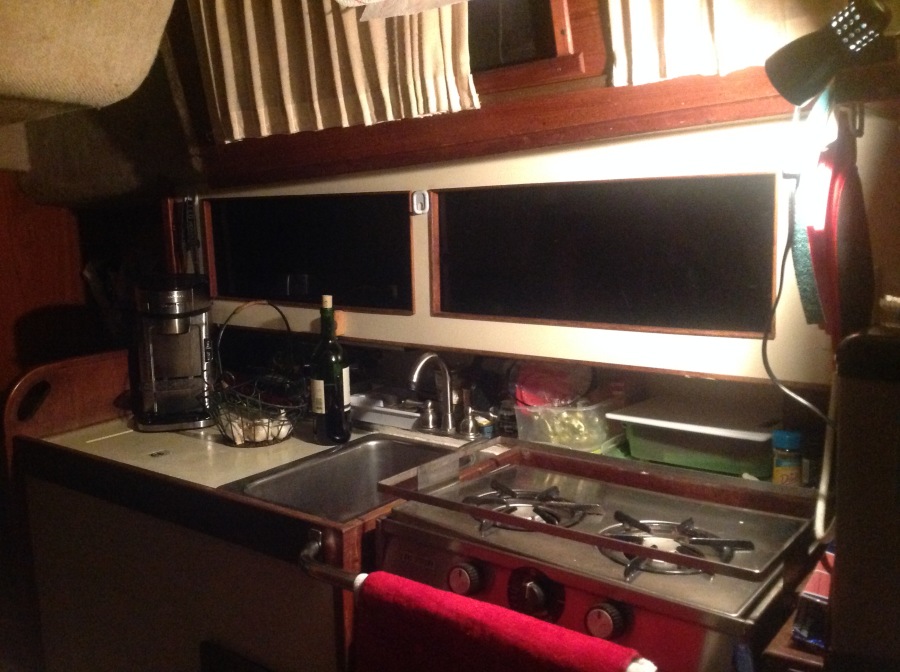
| Eureka!! |
| I scoured the internet again. I found a product that seemed to fit my criteria, but it seemed too good to be true. It wasn’t cheap, but if it would work, I was willing to pay. I found a store in town where I could look at the cabinet,and if my measurements were off, I could return it. It worked! I can access my spices while I am cooking without taking up valuable counterspace. I have been using this for more than 6 monts, and I love it! |
 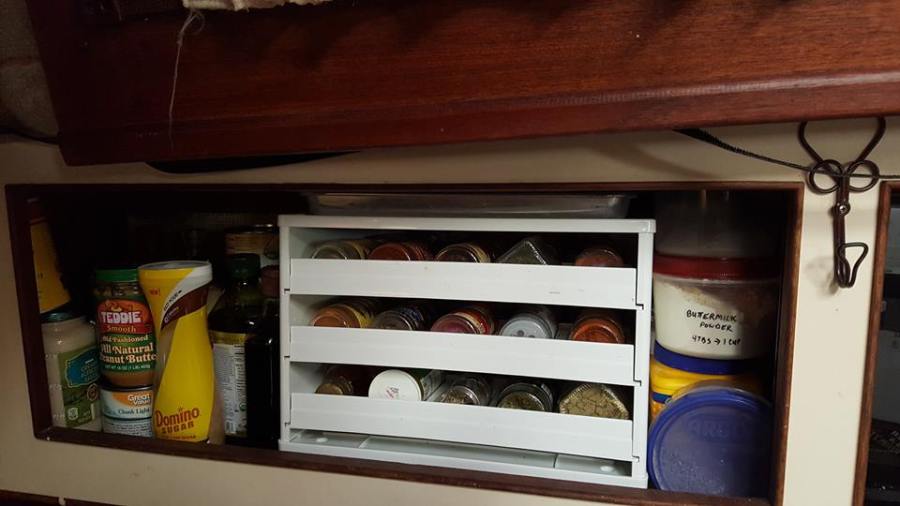 |
| My spice cabinet aboard SV Tumbleweed. |
 After living aboard for a little over a year and a half, we have learned that we need to have sacraficial zinc anodes hanging over the side of our boat to keep the electrolysis from erroding our propellor. Not only do you need the anode, you need to know which one to buy, and how to attach it to your boat properly.
After living aboard for a little over a year and a half, we have learned that we need to have sacraficial zinc anodes hanging over the side of our boat to keep the electrolysis from erroding our propellor. Not only do you need the anode, you need to know which one to buy, and how to attach it to your boat properly.
So what is electrolytic corrosion?
According to Defender: “What is Electrolytic Corrosion? If you’ve noticed corrosion on the metal parts of your boat located below the waterline, you are the victim of “galvanic corrosion”. The scientific term “electrolytic” or “galvanic” corrosion describes the type of corrosion that anodes are intended to absorb. This corrosion is normally caused by different metals being near each other in salt water. Galvanic corrosion, an electromechanical action, causes metal parts to decompose. This destructive process is caused by electrolysis, an electric current set up between the metal parts of your boat, with salt water as the electrolyte. The effect is like a flashlight battery — an electrical current is created and continues until one of the metals is eaten up — the battery goes ‘dead’.”
There are three types of sacraficial anodes, and you cannot use two different type anodes on the same vessel at the same time. The anodes are categorized by water type:
Salt water: use a zinc alloy anode
Salt water and brackish water: use an aluminum alloy anode
Fresh water:use a magnesium alloy annode
These anodes need to be attached to a ground.
We are currently living in a marina in salt/brackish waters where conditions for electrolysis are optimal, so–our sacrificial “zinc” will arrive in the mail next week.
More information can be found at: http://www.boatus.com/boattech/casey/sacrificial-zincs.asp
I have been working diligently on our cookbook, A Taste of Home, and finally finished it. I have been advised to stay off my foot that I injured just after we returned from a trip to New Orleans. Crutches are a real pain when you live on a boat. Our finger dock is fixed, so as the tides go in and out we either have to step up onto the dock or down onto the dock, with up to a 4-foot variation depending on the time of day. We also face south with prevailing winds coming from the West or East, so we might be close to the finger dock, or we might have to pull the boat closer against the wind to get on or off–so I stayed on the boat most of the time to give my foot a chance to heal and put the time to good use, refining my writing projects. (I have also finished a short biography on Thomas Wildcat Alford and a MAP Peer Review.) Download our free cookbook now: Cookbook 2019 1.1.19
UPDATE: The article on Thomas Wildcat Alford will be featured in the Summer 2017 edition of The Chronicles of Oklahoma. Alford Article Available Here
After you have lived aboard a small boat with way too much stuff for a full year in Florida, you realize there are a few things you could have brought with you that you miss, but of the items you thought you might need just take up precious space. The boat seems impossibly cluttered and disorganized, so in preparation for cutting the docklines, lots more stuff needs to go.
Did we use our winter socks, even once during the coldest months here in Florida.? No, nor raincoats, or mittens or winter shirts. How many pans can you use at once on a two burner stove? Do I really need to make a soup pot full of anything for 2 people? How many spatulas do I need? How many blankets, even with company? Did I really use any of those “necessary” resource books? The list goes on. Some things will go to a new permanent home, some to long term storage with family, some items will go to the storage building, just in case I might need them over the next few months so that I don’t have to repurchase anything if I cut back too deeply.
I am so looking forward to feeling less cluttered, now the work begins . . .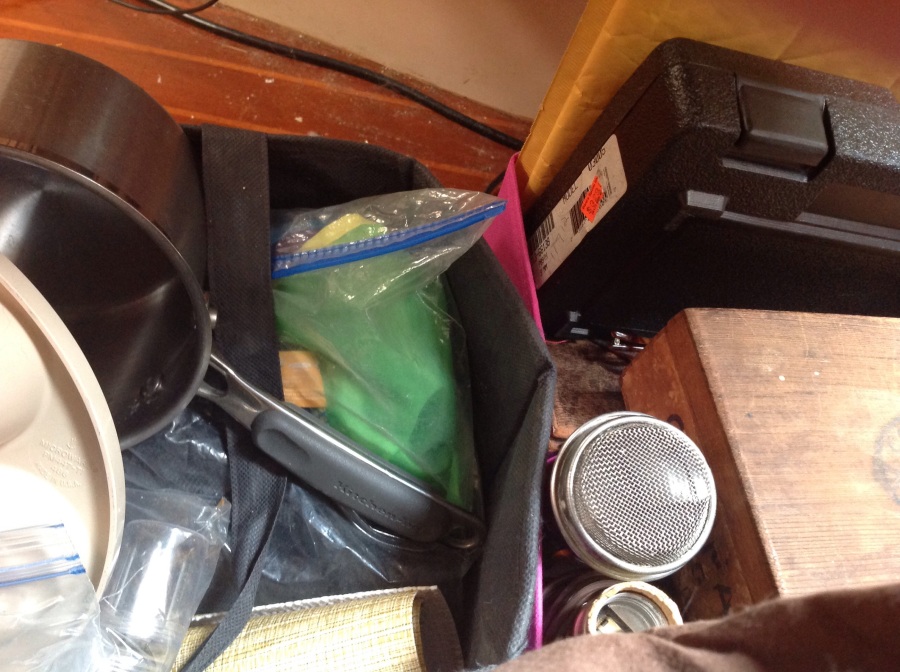
 The adventure really began because we read books together. I was unemployed after moving to Michigan to be with Doug full time. He was a long distance truck driver at the time, traveling mostly in the Midwest region. I collected unemployment and applied for numerous jobs every week, but I was over qualified for most jobs in a tight economy. We spoke on the phone for several hours each day since he was gone all week. When I mentioned a really good book I was reading, he said it sounded interesting, wish he had the time to read. So, I began reading books over the phone so that we were both literally on the same page. We both loved to be around large bodies of water, so boating adventure books seemed in order. While a few of these books are land-based adventures, they all began to feed our increasing wanderlust.
The adventure really began because we read books together. I was unemployed after moving to Michigan to be with Doug full time. He was a long distance truck driver at the time, traveling mostly in the Midwest region. I collected unemployment and applied for numerous jobs every week, but I was over qualified for most jobs in a tight economy. We spoke on the phone for several hours each day since he was gone all week. When I mentioned a really good book I was reading, he said it sounded interesting, wish he had the time to read. So, I began reading books over the phone so that we were both literally on the same page. We both loved to be around large bodies of water, so boating adventure books seemed in order. While a few of these books are land-based adventures, they all began to feed our increasing wanderlust.
An Embarrassment of Mangoes: A Caribbean Interlude by Ann Vanderhoof
A Sail of Two Idiots by Renee Petrillo
Dungda de Islan’ by Charles Dougherty
Eurisco Sail West: A Year in Panama by Connie McBride
Free Country: A Penniless Adventure the Length of Britain by George Mahood
Harts at Sea Sailing to Windward by
Island Fever: Cruising the Bahamas, Caribbean Islands by Betty Karl
Love with a Chance of Drowning by Torre DeRoche
More Ketchup Than Salsa by Joe Crawley
Key West: Tequila, A Pinch of Salt, and A Quirky Slice of . . . by Jon Breakfield
Rupee Millionaires by Frank Kusy
Sailing Misadventures of the Wild Hair by Chip Giles
Seriously Mum, What’s an Alpaca? by Alan Parks
Simply Sailing: A Different Approach to a Life of Adventure by Connie McBride
Skirting the Shore: Reflections on Sailing the Great Loop by Adrian Martin
Stumbling Aboard: A Reluctant First Mate Travels Through 20 . . .by Janice Johnson
Tales of the “Luna C” by Steve Casteel













